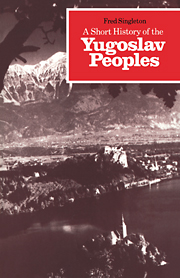Book contents
- Frontmatter
- Contents
- List of tables
- List of maps
- Preface
- Guide to pronunciation
- 1 The lands of the South Slavs
- 2 The early Slav settlers
- 3 The early Slav kingdoms
- 4 The South Slavs under foreign rule
- 5 The development of independence
- 6 The First World War
- 7 The kingdom of Serbs, Croats and Slovenes
- 8 The kingdom of Yugoslavia
- 9 Yugoslavia and the Second World War
- 10 The transition to socialism
- 11 The beginnings of self-management
- 12 The 1960s – a decade of reform
- 13 Tito's last ten years
- 14 Yugoslavia after Tito
- Bibliography
- Index
2 - The early Slav settlers
Published online by Cambridge University Press: 20 February 2010
- Frontmatter
- Contents
- List of tables
- List of maps
- Preface
- Guide to pronunciation
- 1 The lands of the South Slavs
- 2 The early Slav settlers
- 3 The early Slav kingdoms
- 4 The South Slavs under foreign rule
- 5 The development of independence
- 6 The First World War
- 7 The kingdom of Serbs, Croats and Slovenes
- 8 The kingdom of Yugoslavia
- 9 Yugoslavia and the Second World War
- 10 The transition to socialism
- 11 The beginnings of self-management
- 12 The 1960s – a decade of reform
- 13 Tito's last ten years
- 14 Yugoslavia after Tito
- Bibliography
- Index
Summary
The Roman occupation
When the Romans first began to expand into the Balkans in the third century BC, the area was inhabited by Thracian, Illyrian and Celtic tribes. The Thracians and Illyrians had been to a great extent Hellenised during the fourth century BC, when the Macedonian empire of Philip and Alexander flourished. Greek colonies had been established along the Adriatic coastlands even earlier. The Celts, who migrated into the Balkans in the fourth century BC and settled mainly in the northern lowlands, became assimilated into the Illyrian community, the chief legacy of their presence being numerous Celtic elements in place names. For a time before the Roman invasions several powerful Illyrian or Graeco-Illyrian kingdoms existed in places as far apart as modern Albania and Macedonia in the south and the upper Sava basin in the north. Remarkable examples of the wealth, power and high cultural attainments of the Illyrians have been found in the excavations of royal tombs. The friezes which decorate the situla discovered at Vače, near present-day Ljubljana, depict scenes of ritual sacrifices, feasts, battles, sport and pastimes which suggest that a highly organised, metal-using society existed in this area in the fifth century BC. There are signs of both Greek and Etruscan influences.
The Illyrians were the first to feel the power of Rome. During the third century BC Roman attacks began on Illyrian tribes settled in the Neretva valley, followed by raids on the Greek cities on the Albanian coast. Most of the coastlands were brought under Roman rule during the Illyrian wars of Octavian in 35–33 BC.
- Type
- Chapter
- Information
- A Short History of the Yugoslav Peoples , pp. 10 - 23Publisher: Cambridge University PressPrint publication year: 1985



